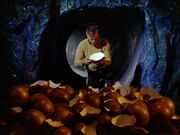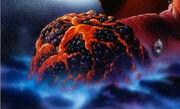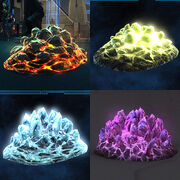The Horta were a silicon-based lifeform native to Janus VI and members of the United Federation of Planets. According to Spock, they were a very emotional as well as intelligent species who appreciate the strengths and differences of others, and they were a literate and tool-using species.
Biology[]

Internal anatomy of the Horta
The Hortas' preferred habitat was amongst the rock of a planet, though they could survive in a typical atmosphere, they found it disconcertingly empty to the touch.
The exterior of a Horta consisted of a brown rocky carapace which was highly resistant to damage; anything but the highest phaser settings felt like nothing more than a mild irritation to the Horta. On their underside, Horta had numerous cilia which they moved about on.

A Horta tunnel
The Horta diet consisted of minerals which they dissolved with a powerful orange acid they secreted from glands all over their bodies; this acid was also the means by which Horta could tunnel through their rocky environment as easily as a humanoid might walk through air. When Horta were afraid, they would lose control of their acid glands and squirt the powerful corrosive all around them. They also have the urge to tunnel to safety, although they can suppress this instinct when needed, such as to not damage the deck plates of a Federation vessel.
Horta sensory organs included the ability to quite specifically detect the chemical composition of materials around them so they could target the most desired minerals. This form of sensory input dominated the Horta's perception of the world, being able to tell what gases made up the air that surrounded them and identifying species by the chemical composition of their blood.
Horta could survive exposure to the vacuum of space, though the shock resulted in a temporary coma. Horta could also happily eat through power conduits, quite unaffected by energies and radiation passing through them. They were equally invulnerable to shields, being able to easily pass through them. (DS9 novel: Devil in the Sky) However, they were not able to survive pure magma, in which they would dissolve in minutes or seconds depending on the surrounding temperature. (TOS novel: Devil's Bargain)
They had poor eyesight and could mostly see in the Infrared spectrum. Their method of hearing involves detecting atmospheric vibrations, and they had a highly developed sense of smell that was used in one of their means of communication.
They also had something of a clan mind and a hive mind, which was a stage on their way to further development into individuals. This hive mind is broken when the All Mother dies. Although telepathic contact would still be possible, especially among clans, the hive mind would break, leaving their mental state isolated from each other. They also had a semi-telepathic bond that communicated feelings rather than intelligent thought. (TOS novel: Devil's Bargain)
Reproduction[]

A hatching Horta
The Horta were extremely long lived, had no natural predators and were practically indestructible; as a result, over time, Horta populations grew substantially. As a means of population control, once every 50,000 years the Horta underwent a mass self induced extinction; the renewal.
Before each renewal the Horta laid their eggs in the Vault of Tomorrow and left a single caretaker, the Prime Mother, to see the next generation into the world.
The Horta also laid eggs between renewals, breeding like any other species. (DS9 novel: Devil in the Sky)
The Hortas employed selective breeding to steadily improve themselves by choosing the best of their generation to be the Prime Mother, resulting in their species being remarkably civilized and intelligent. (TOS novel: The Rise and Fall of Khan Noonien Singh, Volume 1)
They also had genitalia on their undersides. This would show that they were male or female, although a Human would not know their sex unless they spent enough time with them or they show their undersides. (TOS novel: Devil's Bargain)
Maturation[]
Newborn Hortas would burn out of their eggs as fleshy red wormlike creatures, about half a meter long. They quickly developed their rocky armor as they grew. Acid of young Horta is not as strong as that of adults.
Young Horta begin to eat as soon as they are born and quickly grow, reaching adult sizes in a matter of days. (DS9 novel: Devil in the Sky)
When a Horta was about to die, its rocky skin becomes smoother and less bumpy. (TOS novel: Devil's Bargain)
Culture[]
Within their planet lies repositories of their memories written into crystals that were part of the structure of the rock itself which told Horta history. (TOS novel: Devil's Bargain) An example of one of these repositories was the Stone of Memory. (DS9 novel: Devil in the Sky)
The renewal was a major element of Horta culture, the Prime Mother (also known as the All Mother) of each new renewal was a significant figure in each generation of Horta and the young hoped to achieve the privilege of becoming the next Prime Mother at the next renewal. Being the parent (or possibly as far back as a living ancestor) of the next chosen Prime Mother is also considered a high honor and a source of great pride in and of itself. (DS9 novel: Devil in the Sky) The All Mother was a specialized being, with only one born a generation. When her work was done, which was making a new generation, her biology shuts down and the young become individuals. (TOS novel: Devil's Bargain)
The Horta were not capable of spoken speech: they had no mouth, but could communicate by producing rumbling sounds. They could communicate with themselves with smells and psionic waves that allows mental communication. (TOS novel: Devil's Bargain) For ease of communication with humanoids Horta could be fitted with universal translators. Horta were also taught to communicate by etching text into the ground should their translator malfunction. (DS9 novel: Devil in the Sky) Such was the case when first contact was made by the Mother Horta. Using fractured English language from mind melding with Spock, she etched "No Kill I" to express her unwillingness to die, nor cause death. (TOS episode: "The Devil in the Dark") Before the use of the universal translator, the miners of Janus VI used colored marbles that when placed in certain orders could make codes that both sides could translate. They also used a type of wiggling movement, similar to what a bee does, to communicate. (TOS novel: Devil's Bargain)
After the new Horta hatched, they formed clans based on the caste that they were born into and their specialized genomic strengths. Some examples of these clans were the Tunnel Borers and the Hole Diggers. These clans had competition in the way that when one clan works harder than all the rest, this earns them more love from the All Mother. (TOS novel: Devil's Bargain)
Some Horta adorned themselves with rocks for decoration, giving them a blue or green tint instead of regular brown. They were able to "applaud" like other species, except their version consisted of clacking, shuffling, and whistling that sounded like steam. They were interested in profit, using what they earned along with the miners to buy rocks and minerals from other planets, which they considered delicacies. They also had their own myths, with the All Mother telling her children stories about mythical creatures such as lavagoblins and the Ghost-in-the-Rock. (TOS novel: Devil's Bargain)
History[]
Some time prior to the 23rd century, the Borg visited Janus VI; fortunately they did not recognize the Horta as any sort of lifeform and left without attempting assimilation. (ST comic: "A Rolling Stone Gathers No Nanoprobes")

Captain Kirk examining a damaged Horta egg in the Vault of Tomorrow
In the 23rd century the Horta entered into a renewal. While Janus VI appeared uninhabited, the Federation established a mining colony, which the Prime Mother tolerated until 2267. In that year, the miners opened new levels of the mines and damaged eggs in the Vault of Tomorrow. The Prime Mother tried to protect the eggs and killed fifty of the miners, who were not aware of the damage they had done. The mysterious deaths resulted in the USS Enterprise being sent to investigate. Captain James T. Kirk and his first officer Spock conducted first contact with the Horta, Spock communicating via mind meld, and learned why the creature had attacked the miners. (TOS episode: "The Devil in the Dark")
After the misunderstanding was resolved, the remaining Horta eggs hatched, and the species began to thrive once more. By 2300, there were nearly 1,100 new Horta on Janus VI, and fifty years later, there were more than 3,000. The Horta and Humans worked together on the mining operation, which became one of the most productive and profitable operations in the known galaxy, sourcing raw ore and rare elements to the entire Federation. (ST short story: "Mother's Day"; DS9 novel: Devil in the Sky)
Two years after the discovery of the Horta, some of their members were chosen to help save the planet Vesbius from an incoming asteroid. This was the first time that any of their race left their planet. However, before anything could be done, a problem had to be solved first. Instead of the All Mother dying so the children could grow as a species, the children became dependent on her and kept her alive by feeding her offworld minerals. So a proposal was made: when the job was done, Spock (who was able to communicate with them telepathically) would become the new All Mother. But after all the events have happened, Spock (whom allowed the children to call him the "All Father") showed them the error of their ways and that they could not be dependent on their mother or anyone else if they were to grow as a species. (TOS novel: Devil's Bargain)
The Horta-Human mining alliance soon spread to other planets: the first planet found suitable for mining and the dietary requirements of the Horta was Lythos Prime. The operation on Lythos quickly gained a reputation for always meeting its quotas on time. (ST comic: "A Rolling Stone Gathers No Nanoprobes")

Horta Lieutenant Naraht in 2285.
Dahai Iohor Naraht, one of the first Horta hatched, went on to join Starfleet. (TOS novel: My Enemy, My Ally)
Other young Horta to enter Starfleet Academy included Slider Dan, Missile-in-Rock, Crumblecake and Hot-John, four named members of a newly-formed, five-member Star Clan, following an incident on the Enterprise, in which the five are blown out of the shuttle bay into space and must group together to await rescue. (TOS novel: Devil's Bargain)
Doctor Brewster was the Horta leader of a scientific survey on Pegasus IV. (TOS novel: The Starship Trap)
In 2305, the Horta Sanaht began representing Janus VI on the Federation Council. (ST novel: Articles of the Federation)
One of the Dax symbiont's hosts was involved in operations working with Hortas to mine planetary cores. (DS9 novel: Devil in the Sky)
In 2369, the Horta-Human operation on Lythos Prime was attacked by a Borg cube whose sensors had mistakenly detected a carbon-based/silicon-based hybrid species on the planet, kelbonite deposits giving false readings of the Humans and Hortas. After realizing their error, the Borg attempted to assimilate the Horta, but were unable to as the Horta dissolved the drones' injection tubules on contact. Effectively resisted, the Borg retreated. (ST comic: "A Rolling Stone Gathers No Nanoprobes")
In 2370, the Horta-manned starship USS Darwin, commanded by Captain Dalen, assisted the USS Enterprise-D in exploring the dyson sphere the latter vessel had discovered the previous year. (TNG novel: Dyson Sphere)

The Horta Ttan
Also in that year, the Horta Ttan and her family (at the time a clutch of eggs) were recruited to assist in rebuilding Bajor's mining industry, which had been devastated in the Occupation. Unfortunately as the ship transporting the Horta family approached Deep Space 9, it was ambushed by a Cardassian vessel, and Ttan was kidnapped. Ttan was rescued shortly after, but returned to find her children hatched, but no home on Bajor as the Council on Ecological Controls refused to let the Horta settle. Instead Ttan and her family were permitted to take up residence on Bajor's moon Baraddo where they found many valuable mineral deposits. (DS9 novel: Devil in the Sky)
In 2371, Captain Jean-Luc Picard, Spock, and Dr. Lewis Zimmerman attended a ceremony on Janus VI in which Tetsua, the mother of the next generation of Horta, was installed. (TOS short story: "Tears for Eternity")
In 2376, the USS da Vinci aided in stopping a Horta plague on Janus IV. (SCE eBook: Ambush)
In 2379, the Horta Chwolkk became an engineer on the USS Titan. (TTN novel: Taking Wing)

Horta variations in 2409: regular Horta, polytrinic acid Horta, eisilum crystal Horta, dilithium Horta.
In 2409, there were some Horta influenced by various minerals, producing variations in the species. Such variants included the polytrinic acid Horta, the eisilum crystal Horta, and the dilithium Horta. (STO - Romulan Mystery mission: "Mine Enemy")
In 52,267, Tetsua witnessed the hatching of the next generation of Horta. (TOS short story: "Tears for Eternity")
Alternate timelines[]
In an alternate timeline, the Horta became the guardians of the Guardian of Forever in 2464. (ST short story: "Guardians")
Known individuals[]
| This article or subsection has an associated category. | Horta |
|---|
- Brewster
- Chawal Nurel
- Chitan Onaka
- Chwolkk
- Crumblecake
- Dahai Iohor Naraht
- Dahen Tetsu
- Dalai Naran
- Dalen
- Flek
- Hot-John
- Jee
- Kalma Quel
- Kodo
- Missile-in-Rock
- Pr'H'Ska
- Salak Johan
- Sanaht
- Sherd
- Slider Dan
- Tian Kalek
- Tetsu Nelek
- Ttan
- Tten Iohor
- Tulek Melsu
- unnamed Horta:
Appendices[]
Connections[]
Appearances and references[]
Appearances[]
- TOS episode: "The Devil in the Dark"
- TOS novel: Devil's Bargain
- TOS novel: My Enemy, My Ally
- TOS novel: Spock's World
- TOS novel: The Romulan Way
- TOS novel: Swordhunt
- TOS novel: Honor Blade
- TOS novel: The Empty Chair
- TOS movie: Rules of Engagement
- TOS novel: Time for Yesterday
- TOS comic: "Double Blind"
- TOS comic: "Aspiring to be Angels"
- TOS video game: The Kobayashi Alternative
- DS9 novel: Devil in the Sky
References[]
External link[]
- Horta article at Memory Alpha, the wiki for canon Star Trek.
